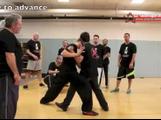Today was the last day of the June 5 and 6 Edmonton Seminar and it provided a background for our next Seminar that will be taught by Allan Belsheim on Cannon Fist Form Basic Choreography and instruction. (TBA)
Master Chen led the class with Silk Reeling working down the body from shoulders to ankles and everything in between. These provide the basic movement patterns for any Taiji form for rotation and building spiral energy into the martial aspect of Taiji. Yilu form and more basic corrections followed and completed the morning activities. After an interesting North India lunch we returned for more education about Daoist philosophy, the start of Cannon Fist basic choreography, as well as a great lecture and discussion by Master Chen including a Chinese character lesson.
Again another fantastic workshop that was inspiring as well as educational on many levels. These workshops always provide more information than can a regular class. As an instructor I try to allow students the chance to gain a high enough level that prepares them for the incredible details that only Master Chen can provide. It was noted those attending today have made progress.
Thanks again to all attendees and especially Master Chen.



{ 2 comments… read them below or add one }
Thank you again Master Chen and Allan for your time, energy, and patience this weekend at the seminar! It was excellent as always.
Below are a few brief notes. These are but a few key points and are as I remember so therefore may need correction!
1.
The biggest enemy to your progress in Taiji is evolution. This is where you are taught something from Master Chen and as you practice and practice you start adding in your own adjustments/interpretations without even realizing it. Later on, you think you’re performing the movement as you were taught, but it has in reality been heavily changed.
Eg: Master Chen tells you to adjust the elbow. You ask, “but what about the shoulder and how does that relate to the kua?”. Simply adjust the elbow. If Master Chen figured you needed to be paying attention to your shoulder or kua at that specific point in time, he would tell you.
2.
Yilu uses ‘reeling energy’.
Erlu uses ‘spring force’.
Basically it is the same spiral energy but issued in different ways (ie: reeling inward; spring force emitting outward).
3.
Yilu: 45 degree angles always used (more neutralizing/defensive).
Erlu: 90 and 180 degrees used (more destructive).
4.
Five bows of Taiji
Actually there are many bows in the body but ‘five’ is used to describe the five main bows we’re aiming to create in practice. Like an actual bow, the 2 ends must be locked/stationary in space in order for the line to be stretched taut. Once this is done the arrow can be released with power. These points will change within the body depending on what you are doing.
5.
Practice doing Yilu very big (we did this Saturday morning a number of times). This will help make sure there is enough movement/stretching happening when doing your form. As you do this you still follow all the basic rules but do not let yourself become overly concerned with little details (relax the mind). Then practice Yilu with precise and great accuracy. Practice both ways. It is open for the student to determine how much each way (what ratio) is practiced.
Thanks, Rion! I had a good time at the workshop too. I created a blog entry and put your comments there as notes from the workshop. It is here: http://practicalmethod.com/2010/06/june-7-2010-edmonton-workshop-notes/